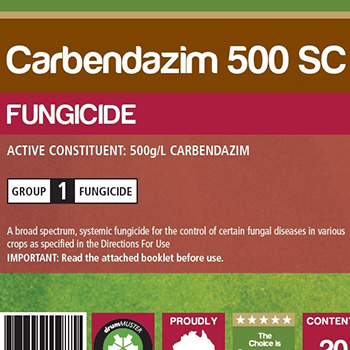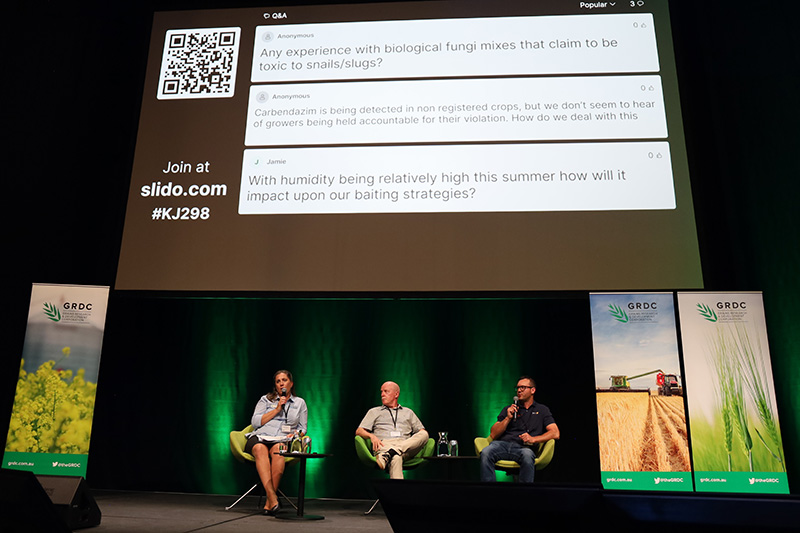Paddock Practices: Carbendazim fungicide and its continued use in Australia
Paddock Practices: Carbendazim fungicide and its continued use in Australia
Date: 27 Mar 2024

Key points
- ONLY use carbendazim in pulse crops as per the label directions.
- It is illegal to use carbendazim for any other purpose or on any crop type not listed on the label.
- Off-label use will lead to detectable chemical residues in grain that puts Australia’s grain exports at serious risk.
- Carbendazim remains a legally permitted treatment in Australia. However, pulse growers are advised to talk to their grain buyer prior to the use of carbendazim.
Carbendazim is a systemic (Group 1) benzimidazole fungicide. It is used to control fungal diseases on some pulse crops in Australia, primarily chocolate spot (Botrytis fabae) on faba beans and grey mould (Botrytis cinerea) on lentils and, to a lesser extent, on vetch and chickpea.
Although these uses of carbendazim remain legal to growers in Australia, in recent years several international regulatory bodies have reviewed and subsequently removed similar registrations for carbendazim. This has led to the removal or significant reduction of Maximum Residue Limits (MRLs) for carbendazim in grain and food commodities in those regions.
When Australia exports grains to another country it must meet the importing requirements of the destination country. This includes the presence of any chemical compounds, the levels of which must be below the importing country’s set MRLs, which may differ from Australian MRLs. In a country where no MRL has been set or it has been removed, then the allowable level is ZERO and any detection is a violation.

Many countries such as China, Japan and those in North America and the European Union (EU) set their own MRLs. Some countries may choose to adopt the Codex Alimentarius MRL standards while others may default to another country’s system in the absence of having an MRL for that chemical and crop.
This highlights the importance of growers always following the label direction when using crop protection products. Doing so will ensure Australian MRLs will be met, allowing the post-farmgate sector, grain buyers and exporters to realistically understand the likely levels of chemicals to be detected, enabling them to manage any risks represented by the importing country’s requirements.
Changing international and Australian regulations
Carbendazim registrations have been removed from several key markets including the EU and North America. It is currently being reviewed at Codex, with a recent recommendation made to withdraw some MRLs due to various concerns.
In 2012 the Australian Pesticide and Veterinary Medicines Authority (APVMA) reported on its review of the active constituent carbendazim and labels relating to its use in Australia. The continued use of the active constituent was supported for chickpea, faba beans, lentil, vetch and macadamia nuts ONLY. All other uses were removed (deregistered) from the label. Find the Carbendazim review findings report (August 2012) on the APVMA website.

Carbendazim and snails
Using carbendazim to control snails in non-pulse crops is not legal in Australia.
Some growers and consultants have observed that using carbendazim on pulse crops to manage fungal disease can reduce the number of round and conical snails present in these crops. As a result, there is some interest in registering carbendazim in pulses and other crops to control snails. However, field research exploring the use of carbendazim to control snails has shown highly variable effects on snail mortality.
Expanding the use of carbendazim for this purpose is not supported by GRDC or the APVMA due to toxicology, human health and environmental risks, and because it is not reliably effective. Consequently, expanding the use of carbendazim for snail management or to other crops will not be pursued by GRDC due to the lack of both registrant (chemical company) support and the poor probability of achieving regulatory approval.
Moreover, there are other ways to manage snails. GRDC has produced Nail the snails – a practical guide to integrated snail control for Australian grain growers, and is investing in a range of other snail research.
Acknowledgement
This GRDC Paddock Practices was produced in collaboration with Gerard McMullen, National Working Party on Grain Protection.

Useful resources
- GRDC Grains Research Update presentation: The market and agronomic challenges of carbendazim usage (6 Feb 2024)
- GRDC podcast: Managing changing MRLs and export implications (20 Sep 2023)
- GRDC podcast: More effective control of pest snails in Australin grain crops (5 Jul 2023)
- GRDC publication: Nail the snails (31 May 2023)
- GroundCover article: Multifaceted approach to combat snails in grain crops (25 Nov 2022)
- GRDC resource page: Slugs and snails
